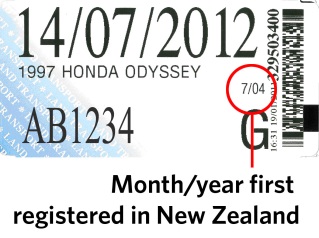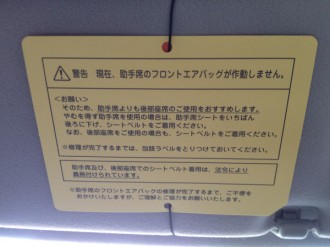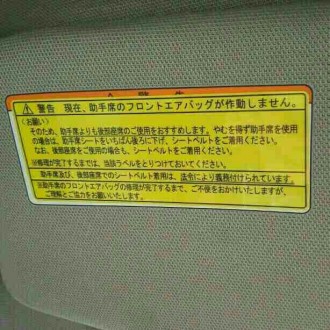Updated: April 2018
It has been difficult ascertaining precise numbers but we are continuing to work with industry representatives and vehicle manufacturers to identify affected vehicles and ensure they’re rectified.
Changes to entry certification requirements in 2016 acted as a means of ensuring no further vehicles entered New Zealand with disabled airbags, but there will be vehicles in use in New Zealand that had this done.
If you don’t already know, find out if your vehicle is part of the Takata airbags recall. The best way to do this is by checking with an official dealer for the make of your car. There is also information available on the government's recalls website(external link), and owners of Japanese used imports should also check the Rightcar website(external link) for a list of Japanese domestic market vehicle makes and models subject to the Takata airbags recall. (Note that because of a lack of information from some manufacturers, not all cars with disabled airbags will have a note added to their Rightcar entry)
The Takata airbags recall was announced in 2013. Toyota NZ informed us that the practice of disabling airbags on their vehicles began in 2015 in response to public concerns in Japan about wait times for replacement airbags as part of the Takata recall. Other manufacturers may have done this at a similar time.
If your vehicle was imported from Japan, confirm when it was imported into New Zealand. The easiest way to do this is to check the date it was first registered in New Zealand. You can find this on the vehicle licence (rego) label on the windscreen – see the diagram below.

Owners of Toyota and Mazda used imported vehicles from Japan can check their licence plate on the Rightcar website(external link) to find out if their car has had its passenger airbag disabled.
It’s important to note that only a percentage of vehicles will have had their front passenger airbags disabled, but all vehicles that fit the criteria should be checked. Your vehicle manufacturer’s representative in New Zealand (such as a local dealership) will be able to provide advice about this.
If your car has (or had, to your knowledge) a Japanese sticker or placard fitted to the passenger sun visor like the examples below, it has had its passenger airbag disabled.


We were advised by Toyota’s New Zealand operation that they had identified this issue in used imports and we acted immediately to investigate it. We understand that Toyota also informed the New Zealand representatives of other manufacturers at that time.
As a safety regulator, we have a number of different roles. We are responsible for setting entry certification requirements which act as a means of ensuring no further vehicles enter New Zealand with disabled airbags.
We also support manufacturers in carrying out recalls – in this situation we are working with representatives of both the new car importers (manufacturers) and the importers of used vehicles to ensure appropriate action is taken. This includes gathering and publishing information, where available, about which cars were recorded in Japan as having had their airbags disabled.
This is ultimately a question of consumer law, and the Consumer Protection website (external link)provides advice on consumer protection matters. For more information contact the Ministry of Business, Innovation & Employment (MBIE) on freephone 0508 426 678 (0508 4 CONSUMER) or by email. You could also discuss this with your motor vehicle dealer, as they may have a view. Toyota NZ, for example, has advised which Toyota vehicles are affected and that its authorised dealers will cover the reconnection of disabled airbags in Toyota vehicles (or replacement of recalled airbags at that time, if possible).
In 2016 we amended entry certification requirements, which all imported used vehicles from Japan must go through. Additional checking of potentially affected vehicles is now required and disabled airbags must be reconnected before vehicles can be certified for use on New Zealand roads.
Due to the way this modification was done in Japan, there is no way of knowing it had happened without additional checks. The modification involved disconnecting the airbag and placing an extra component into the electronics that meant the car’s self-diagnostic systems registered the airbag as being in the vehicle and that it was functioning.
This means that the normal inspection practice of checking the dashboard airbag warning lights would not identify that the airbag had been disabled. A visual check of the connection itself is instead required, which may involve dismantling part of the vehicle’s interior. This additional check has now been added to entry certification requirements.
Reconnected airbags will still be subject to the global recall of Takata airbags. This means that the airbag is still potentially faulty. However, it is safer to have a functioning but potentially faulty airbag than to have none at all.
Only a very small percentage of the potentially faulty airbags are likely to malfunction in a crash, and if an affected vehicle is involved in a crash where the airbag requires deployment, it is highly likely the passenger will sustain serious injury if the airbag is disabled entirely. Airbags are part of a wider system of safety measures built into vehicles and a disabled airbag will also compromise the effectiveness of other parts of that system, such as seatbelts.
We understand that manufacturers in Japan began offering this modification in response to public concern while waiting for replacement airbags under the global Takata airbags recall. We believe that when an airbag was disconnected in Japan, a temporary notice was attached to the sun visor advising it had been disconnected and recommending that the seat was not occupied.
While it was legal in Japan, this modification (to disable the passenger airbag) does not meet New Zealand requirements. This is why we are urging affected vehicle owners to contact motor vehicle dealers to have their vehicles checked and if necessary have the airbag reconnected.
WoF inspectors are now required to check for evidence of disabled front passenger airbags on some Japanese used imported vehicles. If this evidence is found, the car will fail its WoF and the inspector will need to see evidence the airbag is reconnected. We have provided WoF inspectors with some customer information. [PDF, 31 KB]
Our advice, and the advice from manufacturers, is that vehicles under this recall are safe to drive. Recalls happen when there is a potential fault – and only a small percentage of the potentially faulty airbags are likely to malfunction in a crash. We have no evidence of the recalled airbags malfunctioning in New Zealand to date.